"No Way Out" is the definitive Bad Boy album.
That isnít a slight on Biggie - Biggieís legacy is interwoven with Bad Boyís unmistakably and his albums, with their Bad Boy and Puffy influence, are widely and rightly considered to be among the greatest in the history of hop hop. But, weíre not talking hip hop - weíre talking Bad Boy and this was a defining Bad Boy album. Produced almost exclusively by the Combs assembled production outfit, The Hitmen, and featuring guest spots from The Notorious B.I.G., Mase, Faith Evans, 112, Black Rob, The Lox, Carl Thomas, Lilí Kim, Busta Rhymes, Jay-Z, Ginuwine, Twista, Foxy Brown, Kelly Price and Simone Hines, "No Way Out" is that album.
Some of the same people who may criticize this album today, were digging it back in the day. Everybody had this album. Itís the best selling Bad Boy album ever measured by individual units sold, featuring two Hot 100 #1 singles in "Iíll Be Missing You" (certified 3 times platinum) and "Canít Nobody Hold Me Down" (2 times platinum) to go with a #2 in "Been Around the World" (platinum) and a #19 in "Victory" (gold). The album itself was certified 7 times platinum just in the United States by the RIAA. By 1998, it was 5 times platinum in Canada, platinum in the Philippines, Malaysia, Japan, Korea and Switzerland and gold in another 13 countries.
It led to awards for the artist, album and songs from ASCAP (2), the MTV Video Music Awards (2), The Billboard Music Awards (2), the Rhythm & Soul Music Awards (2), the Grammy Awards (2), the Soul Train Awards (2) as well as countless other nominations and victories in award shows throughout the country and the world.
In 1997, Sean Combs was a juggernaut. Not just with his own album, but in his appearances on and production of other artistsí records. 6 songs produced by him held the #1 spot on the Billboard Hot Rap Singles chart for a combined 42 weeks. 5 songs either produced by and/or featuring him held the #1 spot on the Hot 100 chart during the year.
As such, Bad Boy and The Hitmen went on an incredible run. "No Way Out" was the second of three Bad Boy releases in 1997. All of them went #1. The other two, "Life After Death" and "Harlem World" achieved astounding levels of success, as well. 1997 proved to be an incredible year for the label, sales wise, even though it was not without personal tragedy through the devastating loss of Christopher Wallace.
Has it been 10 years already? Well, you know I couldnít just let the day pass without taking a look back at this influential, classic album and giving it itís due. Weíre going to take a behind the scenes look at how this album came to be. To do this, Iíve interviewed producers
Rashad Smith and
Jaz-O (whoís working on a DVD called
"Jaz-O: Be There"), singer
Simone Hines, cover photographer
Michael Benabib (author of
"In Ya Grill: The Faces of Hip Hop") and engineers
Stephen Dent,
Axel Niehaus and Michael Patterson.
The Cover
Letís start where you always start with any album - at the cover. Veteran hip hop photographer Michael Benabib was called in for the shoot.
Benabib: He had actually hired another photographer to do the shoot. Michael Lavine. And Michael Lavine was supposed to shoot the album cover. I ended up going down to Miami and shooting it on spec for myself.
We shot it over a weekend. It was Super Bowl weekend. It was him and his whole crew there. Basically, I would just hang out until Puffy was ready to shoot and he'd call me. He called me playboy. He'd say "hey playboy, let's do this" and we'd do it and then he'd go away for a couple of hours and then he'd feel like taking some pictures some more. And he'd go "hey playboy, what's up? Let's do this again." So, we ended up doing about 4 or 5 different set ups that whole weekend. It was a great experience to be a fly on the wall.
I felt like I was in the Presidential motorcade when we went out to dinner. A line of 8 SUVs going through traffic lights and it was pretty wild and out of control. A difficult thing for me was that my equipment and the clothes [for the shoot] were lost on the plane coming down to Miami. So, we wasted a whole day chasing around Miami International Airport until, finally, they were recovered. That was a big heart attack, essentially.
For that week, Puffy had rented out Cherís house, where all of the photos would be taken, including the one below, an exclusive photo provided to us by Mr. Benabib. In addition to group shots, individual photos of Mr. Combs were also taken.
Benabib: All the different set ups were done on the property. Like the album cover for "No Way Out" is the driveway leading up to the house. We did some by the pool; we did some inside this beautiful vestibule. Those are the places we shot.
It was an incredible mansion we were in for the weekend. Everybody was really enjoying themselves. It was the apex of a moment in hip hop. He had a huge yacht pulled up in front of it, too. Maybe like a 100 foot motor yacht or a 120 foot motor yacht.
The house in question is actually up for sale and you can
view the listing online. Located on La Gorce Island, itís an 11,460 square foot home with 6 bedrooms and 7 and a half baths. The cost? $14,420,000.00. If I had endless reserves of cash, I might just buy it as a Bad Boy fan. If you look at the listing, you can see photos of the property and you can see where the cover was shot as well as where the photo above was taken.
Before it Was "No Way Out"
The album wasnít always "No Way Out". In perhaps itís earliest stage, it was the "Puff Daddy and the Goodfellas" album. This would have seemed to be a collaborative album with the Goodfellas being Puffy, Biggie, Mase, The Lox, Black Rob and perhaps others. They actually put out a rare promotional vinyl release of "Canít Nobody Hold Me Down" by Puff Daddy and Mase. Not Puff Daddy featuring Mase, but Puff Daddy and Mase. It also features "Youíll See" by The Lox featuring The Notorious B.I.G. See the image below.
As it became more a solo project, the forthcoming album was titled "Hell Up in Harlem" as was highlighted on the "Canít Nobody Hold Me Down" CD single (pictured below). But, after Biggieís untimely passing, the album title was changed once again - for the last time - to "No Way Out".
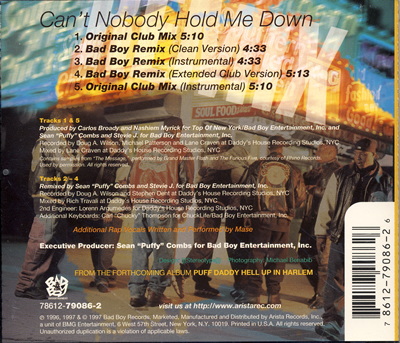
Dent: It just went through a couple main changes. I guess he was trying to figure out what he really wanted to do. The original title of the album was "Puff Daddy and the Goodfellas". That was the original title and then, I think, it went to "Hell Up in Harlem". They did a whole photoshoot kind of like your clean cut gangsters. So, that was the goodfellas, Puff Daddy and the Goodfellas. They all had on suits and stuff. I don't know if you have any of those promo pictures, but that's what like The Lox, Black Rob and Puff - that's how they looked. But, then, I guess, as it just went on, they kept having different visions for the record and then when "Can't Nobody Hold Me Down" came about. I mean, how do you not... I don't even know how he did "No Way Out" - "No Way Out" just came. That was definitely something that came after Biggie passed. The title wasn't final until then.
I don't think [tracks were dropped after Biggie died]... I think we were probably 3 or 4 records in. And I think that's when Puff had the vision of Puff Daddy and the Goodfellas. After that, that's when Big was killed and the direction kind of got a little, a little more serious. I don't remember what was dropped. I really can't remember if there was anything left off of here. It may have been 1 or 2 records. But, I know The Lox ended up having 1 of them on their record or 2 of them on their album. And Mase ended up having something on his album from this album. So, they were used other ways. But, once he sat down and he figured out what he wanted to put on this album, it's like, you know, give that to Mase, Black Rob and The Lox and let them live off of this a little bit.
A Hitmaking Getaway
As discussed in
"Unbelievable: The Life, Death, and Afterlife of The Notorious B.I.G." by Cheo Hodari Coker, the weight of the East/West nonsense and the accompanying threats had taken itís toll on Combs and those around him.
It was decided that they needed to get away to get focused and get back to making hits. So, Combs brought producers Steven "Stevie J." Jordan, Deric "D-Dot" Angelettie, Nashiem Myrick and Ron "AMEN-RA" Lawrence as well as engineers Axel Niehaus and Tony Maserati down to the Caribbean Sound Basin studio in Maraval, Trindad, along with everything that they needed to craft hits.
In the book, Puffy is quoted as saying, "For the next two years, I wanna have radio on lock. Call the girlfriend, wifey, or whatever, and let Ďem know that youíre not gonna be around for a few weeks. Weíre gonna get away from all this drama, put our heads together, and when we come back, weíre coming back with hits."
And they did - coming back with material that would be used on "No Way Out", "Life After Death" and other albums.
Niehaus: I think the lion share of the material that was on No Way Out had been created at the Sound Basin in Trinidad. The 3 engineers that were brought down to do that were Tony Maserati, myself and Doug Wilson was sort of the assistant for both of us. We stayed there for - I forget how long. I think it was almost a month or two months. It was quite a bit of time where we stayed there and essentially did nothing but record all those beats. There were, I think it was 5 different producer camps that were coming down at the time, if I remember right. And then, every once in a while, certain artists flew in. You know, Faith came in to do a whole bunch of vocals. Aaliyah came down and actually was there for 3 days.
Tony got one room, I got another room. We essentially just started working with the producers. Producers had all kinds of beats and they needed to be tracked onto two inch. So, that's what we did. Pretty much day in, day out. When one producer team was done, the other one came in. Obviously, the one thing we didn't think about was sleeping. So, twelve midnight, the third producer team left; the fourth producer team came in and you go like "Alright, this is a really good idea. But, you guys do realize that we have to sleep sometime."
It was quite a cluster of an amazing amount of work that Tony and I did. Every day was just plain work. We worked really, really hard. We hardly took any breaks. It was just - I mean, we're talking fifty, hundreds of beats that were laid down, I remember and that was quite impressive, actually.
Puff was always around. Puff actually stayed at the hotel. Puff was there. And he was always hanging out in one of the other rooms. We didn't do much mixing at the time. It was all about gathering ideas and gathering new tracks and gathering new material. And, at the end of it, we had a couple of sessions where Puff essentially just came into the room and listened to one beat after the another on the DAT of all the stuff we recorded and put together. And then just yayed and nayed it. And he goes like "oh, keep that", "no, I don't like that", "keep that", "no, I don't like that", "I don't know", "oh, that's great" and, at the end of the day, you had the "No Way Out" album.
3/15/96 was my first day at the Carribean Sound Basin. And, that's the thing - [I did] basic tracking of 30 songs on the first day and that was producers Puffy and Nashiem. And, on the second day, we did preproduction and basic tracking of Dramatic by Puffy and Nashiem Myrick, then Puffy and Nashiem Myrick and Deric Angelettie. But, they're all working titles, too, so you don't really know which titles worked out to become what. Puffy and Ron Lawrence. Puffy and Deric Angelettie. Puffy and Nashiem Myrick. And Puffy and Stevie Jordan. It was quite an incredible amount. My last day was 5/1/96.
And we all stayed at the same place and we didn't see much of each other because we really, essentially, just woke up and went into the studio and started working. And Puff just worked incredibly hard. If I can tell you one thing about it, it was the most concentrated work effort that I've seen a producer do in a long, long time. It was great. And he wanted to come out of that time with a lot of material and he sure did. He was a bit of a slave driver, but in a good way. I mean, you didn't really have to, you know what I mean? Like, not in a bad way, but he essentially was just all focused. He was all about getting it done. And I think that focused everybody else really well.
And then we came back and then, obviously, we did a lot of those basic tracking sessions. Then we sort of processed a lot of the things we did there at Daddy's House in the next month.
The Tracks
1. "No Way Out (Intro)"
Dent: On the intro, it was pretty much... Puff had said that he wanted something real dramatic, but not overly done. He just walked in the room and told Stevie J. kind of what he wanted. Said I need an intro, I need it dramatic, but I don't need it too hype, too big of a sound. He said try to keep it simple. Once Stevie J. got it - I think it was probably the first time. Like the first one he played back. He said he liked it and said OK, that's what I'm looking for and now let's take it and add the drama to it by adding sound effects; trying to get to the movie soundtrackish kind of thing so that you can actually hear things in the background and things going on and just try to bring it to life without making it sound too big.
So, that's kind of what he was looking for with that intro. I don't think it took that long to do. I can't really remember the timing of it, but I don't think it took that long to do. I think Stevie J. hit it great - great on the one. And then, it was just a matter of putting the effects and doing some overdubs as far as his vocals to just try to get the vibe for what he wanted to say in there.
Patterson: I just remember getting the files late one night, like after mixing a song. It was mixed in an hour or two and that was that.
2. "Victory" featuring The Notorious B.I.G. and Busta Rhymes
The music video for
"Victory", the
third most expensive music video ever at $2.7 million dollars, starred Puffy and Busta alongside seasoned actors Danny DeVito and Dennis Hopper. The long version of the video ran 8 minutes and was released by marketing in a promotional boxed set (see picture below at right) that featured the video in full along with a "mini-movie soundtrack" CD featuring the Radio Edit, Extended Radio Mix, Drama Mix (my personal favorite) and Instrumental. The song was also given a rock treatment through a remix by the Nine Inch Nailsí Trent Reznor.

Dent: That just happens to be my favorite song ever. I'm trying to remember at what part I came in doing this. I remember tracking the music and I definitely remember tracking all the vocals. There were a lot of overdubs between that came about that I wasn't in on. But, this one in particular, just because when Big is saying "turn up my headphones", he's actually talking to me. So, that's why I love this song so much. It's just one of them records, he just went in there and he destroyed it. I think that was one of the records where I really noticed how good the guy was. When he walked in the room and he really spit on the microphone and he made it happen.
You know, even Puff's performance on there, that's probably one of the best performances, to this day, that he has ever done, to me. I just remember him doing it. He got into it; the vibe of the whole track. That was like his signature track to me. And he really went in and just kicked it in the a**. I mean, that's the only way I can put it. Like, he really did it. To me, to this day, that's his best track ever done. And, to me, that's my favorite Big record of all time.
Big put his part down and then Puff lived with it for a couple days. Then, he came back and he did his part and, like I said, to me, that's totally his best performance ever, that I've ever heard. And then, when they added the Busta element, when Busta came in, you know it was just a big party. Busta had the amplified lyrics and the amplified attitude to go along with it. It just made the record go from sounding regular to an extra ordinary song to me. Every element about it was just... you know, I remember all those sessions pretty much vividly. Especially for "Victory". I can remember almost everyday we spent on this record.
Puff did this while Big was still alive. This whole thing wasn't done while Big was still alive, but this song was definitely done while Big was still alive. Because I remember them talking about it, sitting in a room, saying that this was gonna be the first record off of Puff's album. I think this was probably one of them records that they did just as a, you know, they were just gonna do it and then, OK, yeah, Puff you gonna do an album, yeah, yeah, yeah. It wasn't like a big, yeah, we're serious, we're gonna do a Puff album. It was just OK, yeah, OK this is gonna be your first single, ha, ha, ha; you know what I mean?
And they did the record and that's how it came about. But, I don't think... it wasn't complete while Big was still living. The whole thing, like all the overdubs, all the Busta Rhymes on the track - I don't think that was completed while Big was alive. But, I'm pretty sure Puff's vocals were done while Big was still alive. You know what, don't hold me to that. I do remember them doing this and I remember talking about it and I remember Big being in the room when Puff did his vocals, so, you know, maybe I'm just confusing things. That was a long time ago. I know Busta's part wasn't done until after Big had passed. And some final overdubs that Puff did werenít done. He may have redid his vocals after Big passed, but I'm pretty sure he started before he did.

Patterson: I think the only thing I did was help them with Puffy's vocal set and distortion because I was big into distorted vocals at that point. So, I think that was the only thing I did. It's the first time, I think, in the right speaker, you hear Puffy say something. That is the one song of the whole Bad Boy era, I think, of my time there that I didn't mix that I wish I would have.
I put together Puffy's tour after that and that's what we opened the show with and it was always just like opening an album. It was always such an emotional, powerful thing. And lyrically, it's amazing. It has this dark energy and this heavy energy that I really like and I actually just listen to it and crank it and I always look back on it like I wish I would have mixed that song. The track's amazing. The energy of, you know, Biggie, of course, or Puffy's vocals doing the song, doing his rhyme. And Busta. It's a classic track to me. It's almost like a rock song.
3. "Been Around the World" featuring The Notorious B.I.G. and Mase
Another song with an epic music video, the long version of
"Been Around the World" was around 10 minutes, starring Puff, Mase, Jennifer Lopez, Vivica Fox, Quincy Jones and Wyclef Jean. It was remixed, adding a new third rap verse and bringing Carl Thomas in to provide background vocals. The remix also had a
video, as well. Two mixes by Armand Van Helden, "Armandís Freakshow Mix" and "Armandís Unreleased Project" were also released on vinyl.
Dent: I definitely remember, at first, when Ron Lawrence brought that in. They just played it and, instantly, everybody got up and started dancing and they said, yeah, we definitely want to do this record. And it was tracked, just me and Ron pretty much, in the studio, tracking the record. And some other overdub elements were added by, you know, maybe D-Dot and Stevie J. And a couple other people came in and added some elements to it. It was one of those tracks that, you know, Mase lived in the studio with us for a while and wrote a lot of stuff on this. I know he wrote Puff's part and he wrote his own part. And then just having Big on the hook, that just made the record, really.
[Biggieís hook was done] for this song. That was one of the things that Puff wanted to be on this record. This was another song that was thought of, definitely before Big's passing. So, it was one of those records that could add something to Puff's album. And, like I said, Puff's album wasn't even a serious thought at that time. It was just, OK, weíre gonna do a Puff album. He may have been serious about it - I don't think everybody else was until definitely after Big passing. I think we were like 3 or 4 songs in and then it was like OK, we definitely gotta do this and we gotta make it right and we gotta make it the classic that it is.
4. What You Gonna Do?
Dent: Pretty much all of these records are gonna give me the same memory. Like, Nashiem is a good friend of mine and I tracked a lot of his records and the way he brought stuff in is just really naked and raw and it was a real dirty, grimy kind of vibe to it and just sitting down and tracking it. It didn't take a lot to track the record. But, it was when people sat down to write to it, it was just being in the room and vibing with the writers that came in to write to it.
I remember tracking Lil' Kim doing this, actually. And just trying to figure out how... when the writers write to it, being in the room with them for so long, when they write to it, it's kind of hard to imagine someone else coming over and redoing it, but once you hear Puff doing it - you know he kind of takes over the record. I remember, it just sounded like a Lil' Kim record when she was doing it, because she wrote it from a female perspective, but she wrote it for a man. So, it's kind of like, she wrote it for him and she did a great job at it. This was one of her best rhymes. I mean, it's definitely one of her visual records. She put a lot of visual words on it, so you can actually see the song.
Patterson: I can remember spending a lot of time on this song and other songs, looking for sound effects. Gun shots, things like that. I really like this track and I think he holds his own well.
5. "Donít Stop What Youíre Doing" featuring Lilí Kim
Patterson: This is just a fun track. Just being in the studio with all the different people.
Dent: Lil' Kim wrote on this one, too. Same thing here. She did her thing on this. And, like I said, pretty much all of them are gonna have the same memory. It was pretty much a formula that everybody stuck to. You come in with the track; you took the time to then track all the music out. That might have taken several hours to a day, depending on how much more product needs to be put into it. Little edits, if the song was too long or it needed, you know, an extra verse or something, we would then edit it. But, back then, we didn't have ProTools, we had tape, so that was a big deal.
Then, they would come figure out who was gonna write to the record. A couple different people may have tried to write to it and Puff would probably say "nah, I want to get someone else on it". But, I think, pretty much, he knew what he wanted everybody to do on this album. So, it really wasn't hard to get people to write the right thing, because he knew what he wanted at the top. And, you know, same thing with Kim. Just sitting down with her, she did it.
6. "If I Should Die Tonight (Interlude)" featuring Carl Thomas
One of two dedicated interlude tracks on the album, this song marks the first featured appearance of Carl Thomas on a Bad Boy release. While he did sing on "Life After Death", he was not listed as a featured artist, just noted in the album booklet.
Patterson: I think this was a last minute thing and I think we did it all in one night. Maybe we made the track and then maybe the next night, Carl came in and sang and I mixed it right after that. I'm pretty sure it was something fast like that. Probably got in just before mastering.
7. "Do You Know?"
Kelly Price provided additional vocals to three songs on the album with this being one of them and "Donít Stop What Youíre Doing" and "Young Gís" being the others. This is also one of the four non interlude tracks where there is no featured artist listed and one of four tracks that resulted from a writing collaboration with Todd Gaither (better known as Sauce Money).
8. "Young Gís" featuring The Notorious B.I.G. and Jay-Z
Originally intended to be a Biggie solo track, Diddy put the single recorded verse to use, bringing Jay-Z along for the ride.
Smith: "Young G's" was a record originally for Big, like a B single for one of Big's singles on the first album, on the "Ready to Die" album. And, after Big passed away, Puffy wanted to revisit that song and maybe try to add Jay-Z and a few other people on the record.
I wasn't really around when Puffy pulled up the multitracks for the final outcome of the record, but what I did was mixed the record. I went in and mixed it and he played it for me after he added everybody else on the record. I thought it was amazing when I heard it. When I heard Biggie's final and Jay-Z's final verses on there, I was definitely... I was amazed and I looked at Puffy during mixing and told Puffy that this is gonna be a smash. He agreed with me and we put it out, we mixed it and were happy.
[When Big recorded his verse], it was just me, Big and Puff in the studio. I had the "Young G's" track pulled up and it was just supposed to be for a B side for one of his singles. I don't remember which single it was exactly. So, it was just us 3 in the studio and he loved the track and then he did something to it. But, he didn't get a chance to finish all of it - there was only one verse and, originally, I had done some scratches on it because I'm a DJ as well. So, you know, I put some scratches on it but it was never used for the final mix for "Young G's" on "New Way Out".
9. "I Love You Baby" featuring Black Rob
In addition to appearing on "No Way Out", the track also popped up on the
"Money Talks" soundtrack with another Diddy/Rob collaboration titled, interestingly enough, "No Way Out".
Dent: This was really a Black Rob song and Puff wanted it for his album, so he kind of jacked it from him [laughs], said put me on the third verse and it's going on my album. So, Puff just took over the third verse and put it on his album. I really liked this as a Black Rob track. It was a real good record for him, but you know, that's what you gotta do sometimes to get on Puff's album.
Black Rob had done it for his project, he had done it for his album and then, you know, Puff wanted to get him on the record and he picked that one. He just said you know what, we gotta do something together. So, why not... I'll give you the first two verses, I'll just put me on the end of that and, you know, let it rock. So, that's what he actually did. I mean, it turned out good, you know. I personally like the whole Black Rob song by itself. If you've ever heard it, it's a smash.
Patterson: You know what was always interesting to me and what I think caused a lot of strife later on maybe between like, you know, The Lox and Black Rob and whatever - what I felt at the time, that he had all these remaining artists he was working with that he was working on albums for and then, for his album, he just took the best song of each artist and then said, I'm gonna make this and make this part of my album. Puffy made an amazing album by, you know, taking these other tracks that he was working on and just taking them over. He was already working on them, so why not just make this amazing album? Very interesting to watch.
10. "Itís All About the Benjamins (Remix)" featuring The Notorious B.I.G., Lilí Kim and The Lox
Most people think "the remix? What was the original?" Thatís a fair question. The original "Itís All About the Benjamins" is very rare. But, everything is the same, with the following exceptions. That first beat plays the whole time. There are no other beats. Itís just Puff and The Lox, no Big or Kim. And thatís it, except for one additional Diddy adlib at the end, "Goodfellas - I told you so".
So, when it came time to use the track, they put Big and Kim on it and called it the remix. The track had two rock remixes. The first, "Rock Remix I", brought Dave Grohl, Perfect, fuzzbubble and Rob Zombie onto the track. "Rock Remix II" features subtle differences from the first as well as the addition of Size 14. The
"No Way Out" remix and "Rock Remix I" both had videos. The former had a version where Biggieís verse was removed and replaced with a tap dance sequence featuring Savion Glover. Iíve never actually seen that version of it.
The song was also subject to a number of officially released club mixes, including the "Ainít Armand Mix", "Armandís Gangsta Mental Mix", "DJ Ming & FS Drum Ní Bass Mix", "DJ Ming & FS Jump Up Jungle Mix" and the "Mo Cheddar Mix".
Dent: The Benjamins was definitely a Lox record and then Puff walked in the room and said well, whoever's going first is over. [laughs] I think that was Styles P. He said you're off of this record, you know that's my verse and it ended up being on his album. There was another record he traded them to get on their album, so I can't remember what that one was. It was like a trade, like "yo, I'll give you this one for that one". So, they made the trade. I wouldn't have done it, but they did it.
Patterson: Puffy had two rooms in the studio, Daddy's House. One's an SSL console, one's a Neve. I think, all of them were mixed on the SSL, except for Benjamins, which was a Neve.
The original was done and I really didn't know that much about the original version because this is the remix. The difference is that I did a mix on it and then Puffy's like, "oh, mix it and at the end of the night, we're gonna change something on it". So, then there's the whole outro of the song with Biggie and with Lil' Kim.
So, I think, about 11:00 at night, I think it was D-Dot, came in and we added the stuff at the end, the music at the end. Extended the drums, so it all fit and then flew in Biggie's vocals. I don't remember where it was from or what it was. I think Kim came in and did vocals that night and then we mixed it and maybe we fine tuned it the next day and then it was done. I'm pretty sure that's what happened.
11. "Pain"
"Pain", another Diddy solo track (he performs all 3 verses and the chorus), finds him talking about some of the pain that heís had to deal with in his life. From his fatherís death to the deaths at City College of New York to the death of Biggie, in which the spirit of Big talks to him, telling him to keep working. "Make hits continuous - this is what we do." After his verses are finished, Biggie speaks, offering words of wisdom on the industry.
Patterson: This is a song I can't really think that much on, except just doing the vocals. I know this was a difficult one for him to do vocals on just because of the emotional content. That's all I remember, it was just a tough one vocally for him personally, I think. Not as far as like doing the rhyme or doing anything else, I think it just touched a spot in him that was, obviously, really raw at that point because of [Biggieís] death.
12. "Is This The End?" featuring Ginuwine, Twista and Carl Thomas
This is the first of Twistaís three appearances on Diddy albums. He followed with "Is This The End? (Part Two)" on "Forever" and "Diddy Rock" on "Press Play".
Patterson: We did the vocals for this at Boyz II Men's studio in Philadelphia, in their B room. [Diddy] was working with Boyz II Men in the A room. During breaks, he would come in for an hour or two and we would do vocals on this and various songs and then he'd go back and work with Boyz II Men and then he'd come back and do more vocals and go back and forth. After two days of that, we just drove back to New York and I think we had all the vocals done.
I wasn't that familiar with Twista and I know he was more an old school guy. And my gut feeling at the time was that this was Puffy reaching out to someone as an "I love what you do, be on my album, I'm giving you another shot" kind of thing. And I had never really heard of him and I was completely blown away by this guy. Like watching him do vocals was amazing. I'd never seen anyone really rap this way before. He was just so on the ball. It was kind of amazing.
13. "I Got the Power" featuring The Lox
Jaz-O: Basically, I was in the midst of working with The Lox who, you know, back then were The Warlox. And, they weren't yet signed to Bad Boy. But, I had done 3 songs with them and we did an interlude [the start of what would become "I Got the Power"] that just featured Styles P. And it was right before their signing. They had Ruff Ryders, Dee and Waah, they were in the process of talking with Puff and they had initially brought some other material to Bad Boy or to Puff through Mary J. Basically, at that time, it was still up in the air and the two songs along with the interlude is kind of what punched it.
When Diddy heard the song, when he actually heard the interlude, he was like... it blew him away. So, he was like "this is the one". And, you know, he didn't want to take the song away from them, but he came to me and Ruff Ryders, basically and is like "I want this song". And, you know, to justify him wanting the song and dealing with The Lox at that point, he said, well, let me put The Lox on it and put it on the album. So, I basically went in and knocked it out and, it's cut and dry, that's the story.
I went to the studio to lay the track at Daddy's House and, you know, I was told, through Dee and Waah, the situation with the song and they were telling me like, "yo, Puff wants to use that song for his album". So, I was like, but what about The Lox? You know, because... I do it for the money, but I'm a creative guy and it's like to me, I have a certain code of ethics about things. I felt OK about it being that The Lox were on it and I think Puff kind of read that with me, too, because we know each other from back when, when he used to dance for a couple of people, he used to dance for Father MC and things like that. So, I think he felt that and it was a good idea and the song was good.
It was intended for their own album at one point. But, the main thing was, like they were doing songs and Dee and Waah was telling me they had so many songs, but the producers they were working with, they were missing something. So, as it happened, I was working out at D&D a lot, around that time, because I had put Jay-Z onto working out of D&D. He had done a lot of "Reasonable Doubt" out of D&D. So, I was there all the time. What happened was they heard me playing some beats from the other room. They had booked some time and they came in the room and they were like "yo, what's up?" And he's like "whose beats are those?" Because, especially at that time, a lot of people didn't know that I even produced or made tracks.
I was like "those are my tracks" and they were still like "alright, well, who did them?" And I was like, "me!" [laughs] So, they were like "word?" And I was like "yeah, man, what's good?" It was like "yo, can we hear some more stuff?" So, I was like yeah, of course. I played them a couple of things and then what happened was they came in the room, everybody came in the room and, actually, it was Styles P. and Sheek had come in the room and they just started rhyming off the beat and about a half hour later, Jada came up and Jada started rhyming and he was rhyming for like 20 minutes off the beat.
Incidentally, it wasn't the "I Got the Power" track, it was another track. I'm searching for that still. I think I got it on cassette or something somewhere - it's crazy. But, you know, that's where it all started. So, we exchanged numbers and they started booking time in lieu to that and we just put it together.
That was very key in their signing with Bad Boy at that time and it was a great experience for me. Definitely a landmark in my music production career. So, you know, I was just happy to do it.
14. "Friend" featuring Foxy Brown
With two verses from Puff backed by a single verse from Foxy Brown, the track gives writing credit to both of them plus Jay-Z, Mase, D-Dot, Stevie J. and Jon Astrop (from the sample). Simone Hines is on the chorus.
Hines: At the time, I was recording my solo album with Epic Records. Puffy was doing a remix for the first single, "Yeah, Yeah, Yeah". We were recording the song at his studio, Daddy's House. He approached me in the hallway during a break and told me that he was doing a solo project of his own and wanted me to be a part of it. I was surprised and flattered that he wanted me on the project and I told him, "of course!"
I wasn't sure if he was serious about the offer until a month or so later, when my A&R told me that he received a call from Puffy personally requesting me to appear on a track with him and Foxy Brown. I was very excited, but nervous because I wanted to do well.
It's been quite a few years but I remember that the session was fun. There were the usual hangers on planted on the couch looking cool and I brought a few friends along with me. Puffy was at the boards directing me in the booth and it was an easy, laid back vibe. I recall him telling me at one point that I was singing "too good" and that "for this song, you don't need to use your skills". Which I thought was hilarious! But, I got his point. He wanted a raw, hood sound and my 5 octave perfect enunciation was not required [laughs].
When it was Puffy's turn to record his vocals, I stuck around to watch him in action. Foxy Brown was not present at the session - she had recorded her vocals earlier. From time to time, he would ask for feedback regarding his delivery or if he needed to redo a line or two. The thing about being a big deal is everyone around you wants to please. So everyone kept telling him "it's dope man". I heard a few minor flaws and timidly interjected with my feedback. You could hear a pin drop. Everyone looked at me as if I had committed the cardinal sin by questioning Puff Daddy. But Puff took it all in stride and I recall him saying, "that's what I'm talking about - keeping it real. Let her sit at the board!" So, for the rest of the session, I sat at the mix board and served as the session producer. That's my fondest memory. It's hard to believe its been over 10 years.
15. "Senorita"
The final of four Diddy solo tracks on the album, this one was penned by Puffy and Jadakiss. "Senorita" finds him, in a foreshadowing of "I Need a Girl", rapping to a Spanish girl about getting together.
16. "Iíll Be Missing You" featuring Faith Evans and 112
What can be said? Puffyís tribute to his friend experienced phenomenal success, working both as a track for anyone who had lost a loved one and a track that you could simply vibe to. The song and accompanying
music video were highly decorated, receiving honors from the MTV Video Music Awards (2), The Billboard Music Awards, the Grammy awards and the Soul Train Music awards. In addition to being certified 3 times platinum in the U.S., it was multi platinum in 13 countries by 1998, platinum in another 2 and gold in 3 more.
Dent: That was a real special song because it was like the first thing... you know, we wanted to do something that really represented the way we felt, you know what I mean? And it was really one of the hardest records I think all of us did because it was fresh after Big had passed and we're working on it, it was like the next day after the funeral and a couple people came around, they did a couple tribute records that just didn't catch what we all were feeling. It was a big loss because Big was such a big part of everything that was going on. And it's just that... his energy, his drive and, you know, his humor - it was one of the things that made it good to come to Daddy's House in the days that he was gonna be there. You knew it was gonna be a big party, you knew there was just gonna be a bunch of people and it was gonna be, you know, just a hangout. But you knew work was gonna get done.
So, itís just one of those situations that, once he passed, it was like trying to put into words what that was. And then, it so happens, Stevie J.... it was just one of those things that just happened. He came in with the beat, I got it and everybody heard it and then it was like OK, just run with it. And there's elements and elements and Puff really wanted this to be that over the top, emotional, big ballad. And then using that Sting sample... when that came on and just the work that it took to get it right. There was so many different versions of it and then it just came down to this is it and Puff settled on what he wanted and then, he pretty much had a lot to do with what was written for him because he wanted to make sure his vibe got through. I'm getting chill bones just thinking about it. He wanted to make sure that what was being said was how he felt inside.
And then the whole choir with the kids and Faith Evans. Of course, Faith, that was Biggie's wife at one point and the mother of his child. So, it was just one of those things that when, you know, doing it - it was pretty much the hardest record I've ever done at Bad Boy. It was just trying to make it through - everybody was in tears pretty much every session, trying to make it happen. With 112 singing, Faith, the kids choir, the video and, you know, that was a big record. Real big record to do. And it's something we definitely did the right way.
I think it's just gonna be one of those songs that, no matter what... it's not a record that you're just gonna think of Big in it, you know what I mean? Because people are gonna take it their own way. Like, if you lose someone, I'll be missing you. It's just your way of getting that out to them, just by relating to how Puff felt about Big or how we all felt about Big. But, you take that and you put it in your own context and make it mean what you want it to mean for you and the person that you're missing or the people that you lose. So, this is just one of those timeless records to me. I mean, the Sting sample is timeless anyway, but just what Puff said on it and everything, every element about the record is pretty much timeless to me.
It was supposed to be an overdone record, but it was overdone the right way, too. It gets to the point. Thereís nothing fake about the record because we all felt that way. So, everybody writing it, everybody producing it, everybody engineering it, everybody mixing it, everybody editing, everybody that had anything to do with it knew what had happened and what we all had lost. And it was really a company wide loss, so that was just one of those things.
Patterson: I just remember we were in the studio late one night and Puffy came in and he was like, do me a favor, can you go get The Police album "Synchronicity". So, I walked to Times Square to get the album, because he wanted to sample it and he said he had an idea. So, we looped the song into the MPC and then, I think it was Stevie J., came in and started to do his thing. And, by the end of the night, we had the track and that was pretty much all I worked on for 7 straight days. And it was interesting because we all knew what it was for - you said this is for Biggie. And then 112 came in, Faith came in, everyone came in, added their thing. I just remember it being like one of the most focused days of work I've ever done in my life. But, it was kind of like you knew you were doing something good and you knew you were working on something good, just from the beginning.
And, you know, we did the track, Puffy did his vocals and 112 would come in. I think, every night we had a different person come in to add their parts. By the 7th day, it was mixed and it was done. Then we added the intro and Diddy did the saying over it. And that song actually has given me like the two most rewarding moments of my life, in a way. The two coolest moments of my life, actually.
I was on the subway going on the A train going to Times Square from work, from where I was in Brooklyn and, in the train, it was me and 40 school kids going on a field trip. And they were rowdy. And, just out of no where, their teacher starts singing the chorus to "Missing You" and then all 40 kids start singing it. It was amazing. It was unbelievable. I'm in the subway; the subway's moving and the 40 kids are singing that song. It almost brought me to tears, it was so... like they were all singing and they were happy - it was touching them. Like the fact that you could work on something that touched someone in that way, it's kind of amazing.
[The other moment was the] MTV Video Music Awards where Sting sang it with Puffy. Sting came up with me, because we were working on the track together and the intro piece, he sang to me, the whole thing accapella and suggested that - which is amazing, right? I'm sitting in the middle of it in a chair and he's standing next to me singing the song to me to suggest a change. The change, unfortunately, didn't work for what we wanted to do. Technically, it couldn't work. But, it was kind of amazing, just saying, "wow, here I am, in the middle of Radio City Music Hall, Sting is singing the song to me".
But, you know, those 7 days of working on it, everyone was just like - Puffy was focused, everyone was just focused because we knew this was the right thing to do. Like, it was something we were all working towards. It's kind of amazing. I don't know what to say other than that.

"Canít Nobody Hold Me Down" was the second #1 Hot 100 single from the album. The
video featured cameos from The Notorious B.I.G. and comedian Eddie Griffin and the song was remixed into the "Bad Boy Remix" featuring new verses from Puff and Mase.
Patterson: That may have been the first time I recorded Mase's vocals. It was really difficult for a second because he mumbles. You know, like the way he talks and the way he raps, it's kind of like he has something in his mouth. So, it took me a little bit to get used to that. Once I got used to it and realized it was part of him and it wasn't like the microphone or anything else in the room, I was like, "oh wow, he has a really cool style".
It was [a Mase track]. I think, at that point, Puffy may have been guesting on it instead of it turning out to be the other way around kind of thing. I think it may have been a Mase track first.
Dent: Thatís the staple. I don't even know how to explain it. I mean, that was just one of those records that soon as you heard it, you knew what it was gonna be, you knew it was just gonna be the smash that it was - that it is. Just between him and Mase rocking the record - I can't explain it, it was just hot. And we all knew it when we were sitting in the studio just playing it, everybody. I think that was one of the records that played the most at Daddy's House, just rocking it constantly. You know, while people were still in the recording session, it was just fire and magic all the way through. So, that's how we felt about the record. It was just hot. And then the fact, just the way it was written, him and Puff just going back and forth, was kinda old school, but kinda hot, between the two of them doing that. And then the track is definitely the old school hit that it was. Can't explain it man, it's just hot. It's fire. Nothing special about it, nothing special about making it. It's just a hot record.
The Aftermath
Combs had the credibility as an entrepreneur, executive and producer - "No Way Out" cemented his credibility as a bankable recording and performing artist, leading to increased awareness and notoriety. Before 1997, all 6 albums the label had released had been very successful. However, in 1997, new levels of success were achieved and that only helped to further cement Bad Boy as a stable factory of hits. As the second of that incredible three album trifecta of 1997, "No Way Out" racked up sales, awards and acclaim for everyone involved.
Itís been 10 years and, as in life, much has changed with him and with Bad Boy. Artists change and reinvent themselves. But, at the same time, much has also remained the same.
Patterson: There was a time period, when during the time of "Life After Death", Puffy was Puffy. He was Puffy the executive, front person, director kind of guy to "Life After Death" where Bad Boy was firmly established as the company. But, then, after Biggie died, Puffy became the artist. So, when you look at it, his focus was 100% business before then. There was definitely a period where he became an artist and kind of got lost in being an artist. He's gotta be at parties, jetset, do all that other stuff in a different kind of way then he did before and I think it was like becoming the artist made him lose his way a hair, but to only find it and gain it back.
Now, I think, since then, there's Sean John. He went from being a guy who ran a record label to being, you know, a mogul worth $450 million dollars in various areas of the business. So, you know, I think it's just... it's the different stages of his life that have been interesting to watch. And, I can't say other than that, how, you know, to go from someone who's Sean where you're kind of living on 35th street to having 2 buildings, one for the office, one to live in, in Manhattan. It's been quite an interesting thing to watch, quite an amazing thing to watch. And, I gotta say, for the most part, Puffy is not wrong with things. His gut is always right. That's the one thing I've learned from him the most is just trust your gut. There's something about him that he understands and knows what's going on and he makes the right decisions for the most part on things.
He will always make music and always be someone to push the edge of trends, to push the edge of pop culture and he's such an expressive person that, you know, it's one thing to make music with other people, but it's one thing to make your own music and now that he knows how to express himself in that way, I can't ever see him stopping to want to express. You know, if only 1,000 people buy a record, he'd still do it.
, which are stricter than most other blogs', so please read them before commenting. No advertising (posting links to your site), inflammatory (flaming) remarks, vulgarities (any kind of profanity that you can imagine) or questions about our
or comment deletions. We generally try to maintain a family friendly atmosphere here. Please keep this in mind. A few common examples:
with respect and you'll be fine. As long as you do that, we're happy to have you at the Bad Boy Blog.
Please note that all comments made on entries that are at least 14 days old are moderated.




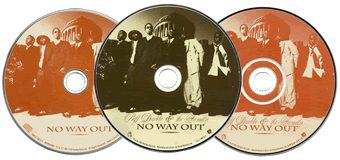
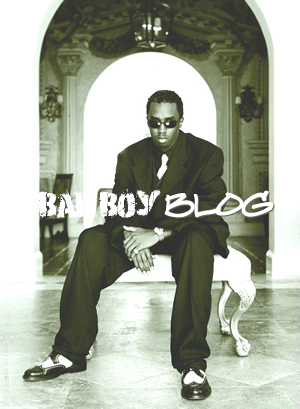
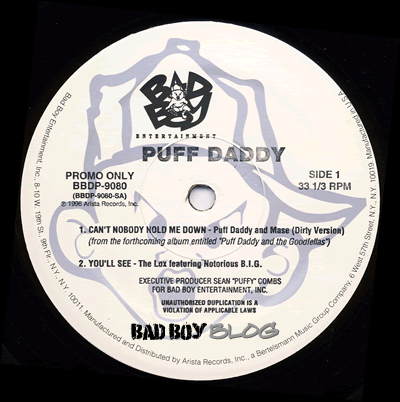

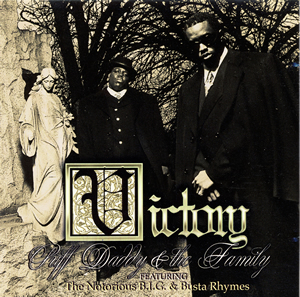


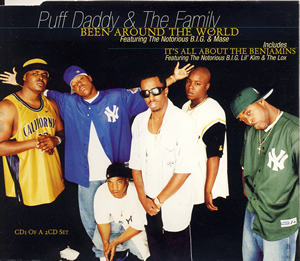
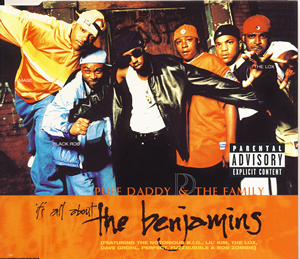
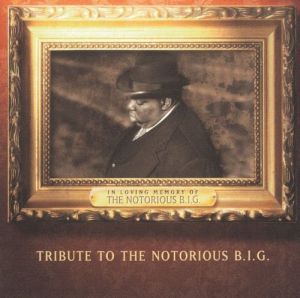

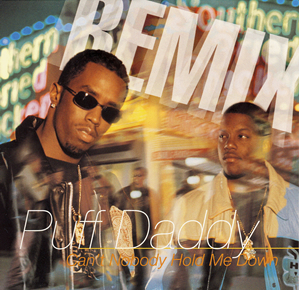
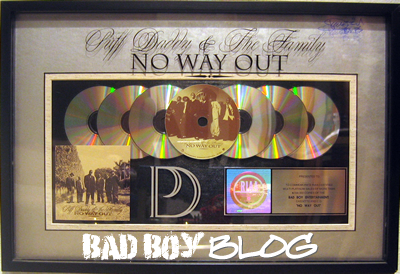
Notoriuos_Hova wrote: